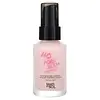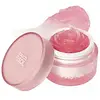What's inside
What's inside
 Key Ingredients
Key Ingredients

 Benefits
Benefits

 Concerns
Concerns

 Ingredients Side-by-side
Ingredients Side-by-side

Cyclopentasiloxane
EmollientWater
Skin ConditioningDimethicone
EmollientDimethicone/Vinyl Dimethicone Crosspolymer
Skin ConditioningPEG-10 Dimethicone
Skin ConditioningDimethicone Crosspolymer
Emulsion StabilisingDipropylene Glycol
HumectantSilica
AbrasivePhenoxyethanol
PreservativeDisteardimonium Hectorite
StabilisingMagnesium Sulfate
Parfum
MaskingMethyl Methacrylate Crosspolymer
CI 77891
Cosmetic ColorantEthylhexylglycerin
Skin ConditioningDisodium EDTA
Aluminum Hydroxide
EmollientStearic Acid
CleansingButylene Glycol
HumectantCI 77491
Cosmetic ColorantSoluble Collagen
HumectantCI 73360
Cosmetic ColorantCamellia Sinensis Leaf Extract
AntimicrobialTriethoxycaprylylsilane
Cyclopentasiloxane, Water, Dimethicone, Dimethicone/Vinyl Dimethicone Crosspolymer, PEG-10 Dimethicone, Dimethicone Crosspolymer, Dipropylene Glycol, Silica, Phenoxyethanol, Disteardimonium Hectorite, Magnesium Sulfate, Parfum, Methyl Methacrylate Crosspolymer, CI 77891, Ethylhexylglycerin, Disodium EDTA, Aluminum Hydroxide, Stearic Acid, Butylene Glycol, CI 77491, Soluble Collagen, CI 73360, Camellia Sinensis Leaf Extract, Triethoxycaprylylsilane
Water
Skin ConditioningSodium Acrylates Crosspolymer-2
AbsorbentGlycerin
HumectantButylene Glycol
HumectantDipropylene Glycol
Humectant1,2-Hexanediol
Skin ConditioningPEG-40 Hydrogenated Castor Oil
EmulsifyingCaprylyl Glycol
EmollientCarbomer
Emulsion StabilisingTromethamine
BufferingEthylhexylglycerin
Skin ConditioningTheobroma Cacao Extract
Skin ConditioningSodium Hyaluronate
HumectantPrunus Serrulata Flower Extract
Skin ConditioningCaprylic/Capric Triglyceride
MaskingPaeonia Albiflora Flower Extract
TonicDextrin
AbsorbentAlaria Esculenta Extract
Skin ProtectingPseudanabaena Galeata Extract
Skin ConditioningCI 17200
Cosmetic ColorantParfum
MaskingCitronellol
PerfumingHexyl Cinnamal
PerfumingLinalool
PerfumingGeraniol
PerfumingWater, Sodium Acrylates Crosspolymer-2, Glycerin, Butylene Glycol, Dipropylene Glycol, 1,2-Hexanediol, PEG-40 Hydrogenated Castor Oil, Caprylyl Glycol, Carbomer, Tromethamine, Ethylhexylglycerin, Theobroma Cacao Extract, Sodium Hyaluronate, Prunus Serrulata Flower Extract, Caprylic/Capric Triglyceride, Paeonia Albiflora Flower Extract, Dextrin, Alaria Esculenta Extract, Pseudanabaena Galeata Extract, CI 17200, Parfum, Citronellol, Hexyl Cinnamal, Linalool, Geraniol
Ingredients Explained
These ingredients are found in both products.
Ingredients higher up in an ingredient list are typically present in a larger amount.
Butylene Glycol (or BG) is used within cosmetic products for a few different reasons:
Overall, Butylene Glycol is a safe and well-rounded ingredient that works well with other ingredients.
Though this ingredient works well with most skin types, some people with sensitive skin may experience a reaction such as allergic rashes, closed comedones, or itchiness.
Learn more about Butylene GlycolDipropylene Glycol is a synthetically created humectant, stabilizer, and solvent.
This ingredient helps:
Dipropylene glycol is technically an alcohol, but it belongs to the glycol family (often considered part of the ‘good’ alcohols). This means it is hydrating and gentle on skin unlike drying solvent alcohols like denatured alcohol.
As a masking agent, Dipropylene Glycol can be used to cover the smell of other ingredients. However, it does not have a scent.
Studies show Dipropylene Glycol is considered safe to use in skincare.
Learn more about Dipropylene GlycolEthylhexylglycerin (we can't pronounce this either) is commonly used as a preservative and skin softener. It is derived from glyceryl.
You might see Ethylhexylglycerin often paired with other preservatives such as phenoxyethanol. Ethylhexylglycerin has been found to increase the effectiveness of these other preservatives.
Parfum is a catch-all term for an ingredient or more that is used to give a scent to products.
Also called "fragrance", this ingredient can be a blend of hundreds of chemicals or plant oils. This means every product with "fragrance" or "parfum" in the ingredients list is a different mixture.
For instance, Habanolide is a proprietary trade name for a specific aroma chemical. When used as a fragrance ingredient in cosmetics, most aroma chemicals fall under the broad labeling category of “FRAGRANCE” or “PARFUM” according to EU and US regulations.
The term 'parfum' or 'fragrance' is not regulated in many countries. In many cases, it is up to the brand to define this term.
For instance, many brands choose to label themselves as "fragrance-free" because they are not using synthetic fragrances. However, their products may still contain ingredients such as essential oils that are considered a fragrance by INCI standards.
One example is Calendula flower extract. Calendula is an essential oil that still imparts a scent or 'fragrance'.
Depending on the blend, the ingredients in the mixture can cause allergies and sensitivities on the skin. Some ingredients that are known EU allergens include linalool and citronellol.
Parfum can also be used to mask or cover an unpleasant scent.
The bottom line is: not all fragrances/parfum/ingredients are created equally. If you are worried about fragrances, we recommend taking a closer look at an ingredient. And of course, we always recommend speaking with a professional.
Learn more about ParfumWater. It's the most common cosmetic ingredient of all. You'll usually see it at the top of ingredient lists, meaning that it makes up the largest part of the product.
So why is it so popular? Water most often acts as a solvent - this means that it helps dissolve other ingredients into the formulation.
You'll also recognize water as that liquid we all need to stay alive. If you see this, drink a glass of water. Stay hydrated!
Learn more about Water